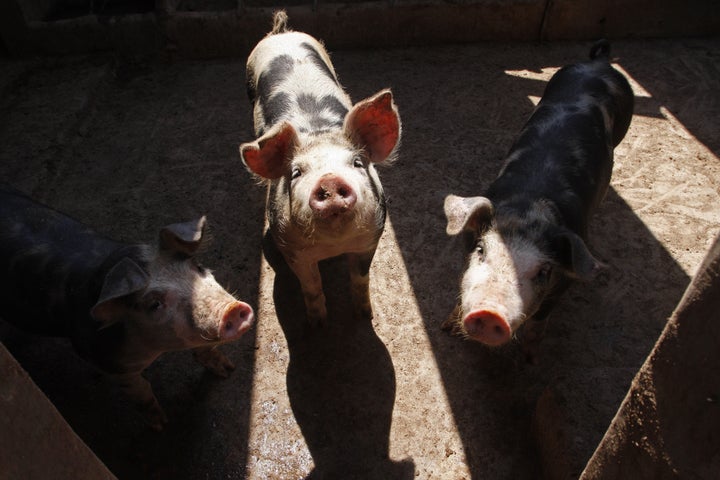
A single sneeze propels 100,000 droplets into the air at around 90 mph, landing on door knobs, ATM keypads, elevator buttons, escalator railings, and grocery cart handles. In a subway station at rush hour, according to British researchers, as many as 10 percent of all commuters can come in contact with the spray and residue from just one sneeze (or sternutation). That means as many as 150 commuters can be sickened by one uncovered achoo.
No wonder health officials are extremely concerned about the new strain of swine flu that has infected at least 20 Americans in five states, killed some 80 people in Mexico, and has traveled to the other side of the world in New Zealand. Understandably, US authorities - following the lead of the World Health Organization (WHO) - have declared a "public health emergency."
"This virus has, clearly, a pandemic potential," says Margaret Chan, director general of WHO. Why? The virulent new H1N1 swine flu strain spreads quickly and efficiently from human to human. It's "a completely novel virus," says the CDC (Centers for Disease Control and Prevention). This latest variant is a mixture of human virus, bird virus, and pig viruses from all over the world. Experts say it's particularly worrisome because people are getting sick without any encounters with pigs. Even worse, young, healthy people (ages 20-40) are dying at a striking rate, a telltale sign of the worst flu epidemics.
Swine flu fears aren't new in the United States. In February 1976, a 19-year-old army private at Fort Dix, New Jersey, died within 24 hours of becoming infected with swine flu. Soon, 500 soldiers were afflicted and the US government began a controversial nationwide vaccination campaign. Ultimately, some 40 million Americans were inoculated. As a result, several hundred people developed Guillain- Barré syndrome, a serious neurological condition, and the immunization program was stopped.
What's going to happen this time? Without question, the disease will spread farther and wider. At this point, as the CDC says, it can't be contained or controlled. (The flu shot from last fall, for instance, won't combat this strain).
What can you do to protect yourself? "No single action will provide complete protection," the CDC notes, but taking a few steps can help reduce the likelihood of transmission of swine flu (or many other infections).
1. Sanitize -- i.e. Wash Your Hands Frequently. It may sound obvious, but hand-washing with soap and water for around 20 seconds is the single best thing you can do (if you're going to go out into the world and interact with other human beings). The CDC estimates that 80 percent of all infections are spread by hands. If you can't wash your hands regularly, try hand-sanitizers with 60 percent alcohol content.
2. Avoid -- i.e. Engage in "Social Distancing." That's the fancy term for reducing unnecessary social contact, staying away from crowds, and avoiding people if you're sick or if you're concerned that they may be infected. It may not be especially practical when you have to go to, say, work, but experts believe it's worth repeating: Isolation and avoidance reduce your chances of getting infected or infecting others.
(Researchers in the UK - mentioned above and sponsored by a cold remedy company - found that 99 percent of commuters suffer at least one cold per winter. By contrast, 58 percent of people who work from home and 88 per cent of those who walk to work caught a cold last winter).
If you need to go someplace crowded, the CDC says, try to spend as little time as possible and try to stay six feet away from potentially infected people. Wearing a surgical or dental facemask - cleared by the FDA as a medical device - "can help prevent some exposures," the CDC says, but they're not foolproof.
3. Be Alert -- i.e. Recognize the Symptoms and Get Help. Swine flu symptoms are similar to regular flu: Fever, body aches, sore throat, cough, runny nose, vomiting, diarrhea, and lethargy. If you don't feel well, seek medical attention. So far, it's important to note, this swine flu is treatable (and absolutely survivable). It's resistant to two of four antiviral drugs approved for combating the flu: Symmetrel and Flumadine. But two newer antivirals - Tamiflu and Relenza - appear to work. What are the chances of a global pandemic? "The situation is uncertain and unpredictable and likely to be a marathon more than a sprint," says Dr. Richard Besser, acting director of the Centers for Disease Control and Prevention.
"We expect there to be a broader spectrum of disease here in the U.S.," adds Dr. Anne Schuchat, interim deputy director for the agency's Science and Public Health Program. "I do fear that we will have deaths here."
Swine flu will dominate news headlines in the days ahead. Every case around the world will be carefully tracked and tallied -- and deservedly so. It may not sound like much, but the best defense involves some very simple steps: Every sneeze should be covered -- preferably with the crook of an arm - and every hand should be washed ... and washed again.
For more information about swine flu or surviving other kinds of life-changing adversity, please go to TheSurvivorsClub Website.
The CDC has set up a toll-free hotline: 1-800-CDC-INFO. Or check out the CDC Website.